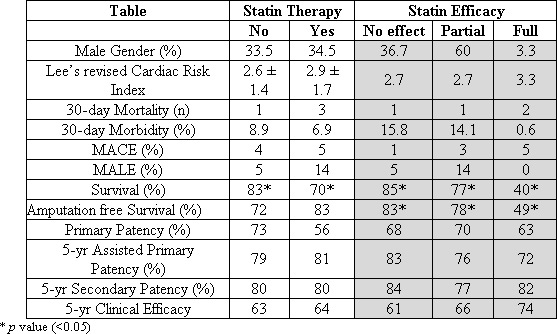|
|
 |
Back to Annual Symposium Program
Impact of effective Statin therapy on SFA interventions for claudication
Charudatta Bavare, MD, MPH, Christopher Smolock, MD, Mitul S. Patel, MD, Javier Anaya-Ayala, MD, Joseph Naoum, MD, FACS, Eric K. Peden, MD, Hossam El Sayed, MD, Ph.D, Jean Bismuth, MD, FACS, Alan Lumsden, MD, FACS, Mark G. Davies, MD, PhD, MBA, FACS.
The Methodist Hospital, Houston, TX, USA.
Background: Controlling lipids particular cholesterol and LDL is an accepted pre-requisite in the effective management of the atherosclerotic patient. Many patients present for superficial femoral artery (SFA) intervention on statins but it is unclear if this therapy has achieved its primary goal of a reduction in total cholesterol (less than 200 mg/dl) and a reduction in LDL(less than 100 mg/dl). The aim of this study is to determine the impact of effective statin therapy on patient and procedural outcomes following SFA interventions in patients with claudication.
Methods: A database of patients undergoing endovascular treatment of the SFA for claudication between 1999 and 2011 was retrospectively queried. The analysis examined patients on statins and not on statins (No Statin) at the time of intervention and the statin group was subdivided into those with cholesterol and LDL patterns which were not (partly (Partial) or completely (Total) controlled under current national guidelines. The primary comparison was between those receiving statins or not and the secondary analysis determined the impact of the effective statin therapy on outcomes. Kaplan-Meier survival analyses were performed to assess time-dependent outcomes.
Results: 573 patients (68% male, average age 67 years) underwent endovascular treatment for symptomatic SFA disease. 52% were on stains at time of the procedure. Of those on stains 93% had an acceptable cholesterol, 5% had an acceptable LDL and 5% had both. Patients on statins presented with a greater number of TASC-II C and D type lesions (21.3%) than patients not on statins (11.3%)
Conclusions:
There is a low penetrance of statin administration among patients with claudication. The effectiveness of anti-lipid therapy is poor. Patients on statins have a higher cardiac risk and a greater burden of disease as determined by TASC-II guidelines. The presence of statin therapy has a favorable effect on peri-operative outcomes and long term clinical efficacy, but seems not to improve over-all survival and limb complications 
Back to Annual Symposium Program

|


